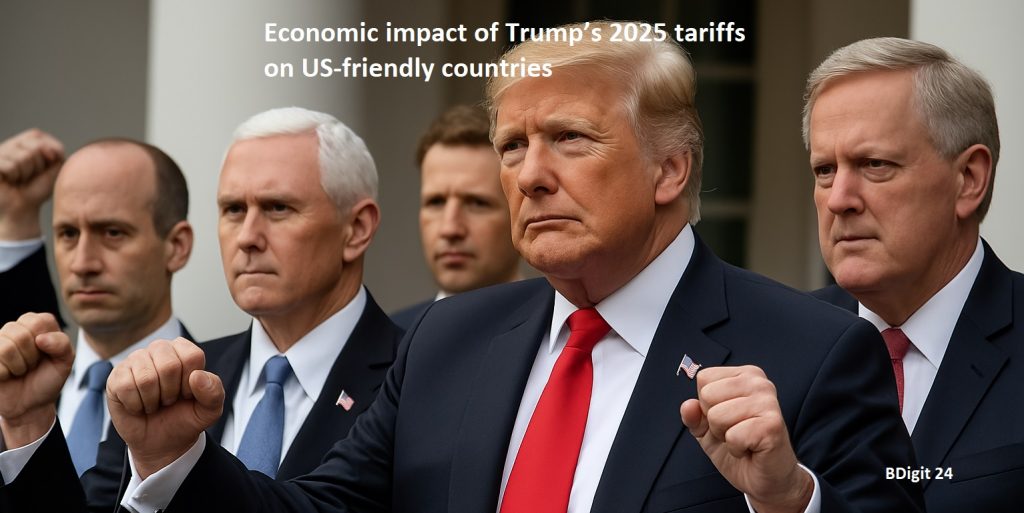How New 10%-50% Tariffs on Allies Like the EU, Australia, and Vietnam Are Reshaping Trade—and Why Economists Warn of $3,800 Household Losses
The 2025 Tariff Landscape: Who’s Affected?
In early 2025, former U.S. President Donald Trump unveiled sweeping tariffs targeting both allies and strategic partners, escalating trade tensions to levels unseen since his first term. The measures include:
- 50% tariffs on France’s Saint Pierre and Miquelon islands and Lesotho.
- 49% on Cambodia, 48% on Laos, and 46% on Vietnam.
- 20% on all Chinese imports, doubled from an initial 10% in February.
- 10% on parts of Australia, including Norfolk Island, while exempting Canada and Mexico from new duties.
These tariffs, branded as “reciprocal” to address trade imbalances, have drawn criticism for disproportionately impacting smaller economies. For example, Lesotho,a nation Trump dismissed as “unknown”, faces a 50% tariff despite minimal U.S. trade ties, while Russia avoided new levies despite $3.5 billion in bilateral trade.
Economic Impact: Households and GDP Under Pressure
The tariffs’ ripple effects are stark:
- Consumer Costs: The Budget Lab estimates a 2.3% rise in prices from all 2025 tariffs, equivalent to $3,800 in annual household losses. Low-income families face disproportionate burdens, losing $1,700 yearly.
- Sectoral Strain: Apparel prices could surge 17%, while the Tax Foundation warns of 600,000 lost U.S. jobs and a 0.65% GDP decline.
- Long-Term Damage: Yale researchers project a 0.6% permanent GDP contraction ($180 billion annually) if tariffs persist, with exports plummeting 18.1%.
Example: A 20% tariff on Chinese goods triggered a 15% retaliatory levy on U.S. agricultural products, hitting soybean and pork exporters. China also suspended lumber imports and revoked licenses for three U.S. firms.
Global Reactions: Retaliation and Alliances
1. China’s Strategic Pushback
China responded to Trump’s tariffs with measured countermeasures:
- 15% tariffs on U.S. coal, LNG, and select farm goods.
- Antitrust probes into Google and export controls on critical metals like tungsten.
- A U.S.-Japan-South Korea supply-chain pact to mitigate tariff impacts, finalized in March 2025.
Notably, China targeted $20 billion in U.S. goods versus America’s $450 billion levy, signaling restraint to avoid escalation.
2. EU and Australia’s Defiance
- The EU condemned Trump’s 20% tariff on European goods as “economically destructive,” vowing WTO challenges[AP News].
- Australia protested 29% duties on Norfolk Island (population: 2,000), calling them “disproportionate and punitive”.
3. Corporate Adjustments
Retail giants like Walmart and Costco pressured Chinese suppliers to lower prices, while China’s Commerce Ministry held emergency talks with U.S. firms.
The Road Ahead: Negotiations and Uncertainty
Despite the chaos, Trump hinted at tariff reductions to facilitate a TikTok sale, underscoring the policy’s unpredictability[Wikipedia]. Meanwhile, the U.S. Treasury explores customized tariff tiers for major trading partners, though implementation challenges persist.
Key Takeaway: While tariffs may boost government revenue by $229–263 billion in 2025, economists warn the costs, higher prices, job losses, and strained alliances, outweigh short-term gains.
Conclusion
Trump’s 2025 tariffs have thrust the global economy into uncharted waters, blending protectionism with geopolitical gambits. As households brace for higher costs and nations retaliate, the world watches whether these measures will force trade concessions, or deepen a protracted economic cold war.
#TradeWar2025 #TrumpTariffs #GlobalEconomy #USChinaTrade
[BBC, Wikipedia, Statista, Yale Budget Lab, AP News, The Conversation,Tax Foundation]


